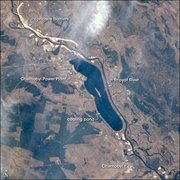Chernobyl
|
|
- Chernobyl is also the name of a computer virus first propagated in 1998.
Chernobyl (Ukrainian: Chornobyl (Чорно́биль), Russian Chernobyl (Черно́быль) is a city in northern Ukraine, near the border with Belarus (Template:Coor dms). It was a major communications node and important centre of trade and commerce, especially in 19th century. The city is located 20 kilometers (12 miles) south of the Chernobyl nuclear power plant, notoriously known for the Chernobyl accident. The plant exploded on 26 April 1986, clouds of radioactive particles were released, and the severely damaged containment vessel started leaking radioactive matter. More than 100,000 people were evacuated from the city and other affected areas. Despite radiation still emitted from the nuclear disaster site, the 800-year-old city of Chernobyl survives, although barely. As of 2004, government workers still police the zone, trying to clean up radioactive material. About 700 — mostly elderly people — have decided to live with the dangers and have returned to their hometown.
Name origin
The city is named after the Ukrainian word for mugwort (Artemisia vulgaris), which is "chornobyl". The word is a combination of chornyi (чорний, black) and byllia (билля, grass blades or stalks), hence it literally means black grass or black stalks.
Sometimes chornobyl is erroneously translated as simply "wormwood" (which most commonly refers to Artemisia absinthium), with consequent apocalyptic associations, probably originating from a New York Times article by Serge Schmemann, Chernobyl Fallout: Apocalyptic Tale, July 25, 1986. The article quoted an unnamed "prominent Russian writer" as claiming the Ukrainian word for wormwood was chernobyl.
In fact, there are over 160 kinds of Artemisia, and the terminology is not generally accepted. Some sources refer to Artemisia vulgaris as "common wormwood", while other claim that "common wormwood" is Artemisia absinthium.
Wormwood is a different (but related) plant, Artemisia absinthium, Полин (Polyn). "Polyn" has no English equivalent, but corresponds to the botanical genus Artemisia. Botanically, mugwort is "Common Polyn" (Ukr. Полин звичайний); while wormwood is "Bitter Polyn" (Ukr. Полин гіркий).
Still more confusion comes from the fact that the word "wormwood" is used in the English text of the Apocalypsis, whose usage as the name of a plant does not necessarily match that of the original Greek.
Chernobyl bears poetic connotations in folklore, for a number of reasons. Its strong smell is evocative of the steppe, as various species of Artemisia are widespread there. Chernobyl roots were used in folk medicine to heal neurotic conditions, although an overdose could lead to neurological disorders, including memory loss.
History
Chernobyl first appeared in a charter of 1193 described as a hunting-lodge of knyaz Rostislavich. Some time later it was taken into the Grand Duchy of Lithuania, where it became a crown village. The castle was built for defence against marauding Tatars. In 1566, three years before the Grand Duchy's rule, Ukrainian provinces were transferred to the Kingdom of Poland, Chernobyl was granted in perpetuity to a Captain of the royal cavalry, Filon Kmita, who thereafter styled himself Kmita Czarnobylski. In due course, it passed by marriage to the Sapiehas, and in 1703 to the Chodkiewicz family. It was annexed by the Russian Empire after the Second Partition of Poland in 1793.
Chernobyl had a very rich religious history. The Jewish community, which formed an absolute majority, would probably have been imported by Filon Kmita as agents and arendators during the Polish campaign of colonisation. Later on, they would have included Chasidim as well as Orthodox Jews. The Ruthenian peasantry of the district would have largely turned to the Greek Catholic (Uniate) religion after 1596, only to be forcibly converted to Russian Orthodoxy by the Tsars.
The Dominican church and monastery were founded in 1626 by Lukasz Sapieha, at the height of the Counter-reformation. In those days, Chernobyl was clearly a haven of toleration. There was a group of Old Catholics, who opposed the decrees of the Council of Trent, just as the seventeenth century saw the arrival of a group of Raskolniki, or "Old Believers", from Russia. They all escaped the worst horrors of the Chmielnicki Uprising of 1648-54 (also known as Polish-Cossack War) and those of 1768-9, when one of the rebel leaders, Bondarenko, was caught and brutally executed by Jan Karol Chodkiewicz's hussars.
The Dominican monastery was sequestrated in 1832, the church of the Raskolniki in 1852. Since 1880, Chernobyl has seen many changes of fortune. In 1915, it was occupied by the Germans, and in the ensuing Russian Civil War, was fought over by Bolsheviks, Whites, and Ukrainians. In the Polish-Soviet War of 1919-20, it was taken first by the Polish Army and then by the Red Cavalry of the Red Army. From 1921, it was incorporated into the Ukrainian SSR, and experienced the mass killings of Stalin's collectivisation campaign and Holodomor. The Polish population was deported during the Frontier Clearances of 1936. The Jewish community was killed by the Nazis during the German occupation of 1941-44. Twenty years later, it was chosen as the site of one of the first Soviet nuclear power stations.
On April 26, 1986, the Chernobyl-4 nuclear reactor, located 10 km to the north of the city, exploded. All permanent residents were evacuated because radiation levels in the area had become unsafe.
Related articles
- Chernobyl accident
- Pripyat, Ukraine
- Zone of alienation
- Elena Filatova
- Chernobyl (Hasidic dynasty)bg:Чернобил
cs:Černobyl da:Tjernobyl de:Tschornobyl es:Chernóbil fi:Tshernobyl fr:Tchernobyl it:Chernobyl he:צ'רנוביל hu:Csernobil nl:Tsjernobyl ja:チェルノブイリ no:Tsjernobyl pl:Czarnobyl ru:Чернобыль sv:Tjernobyl uk:Чорнобиль

